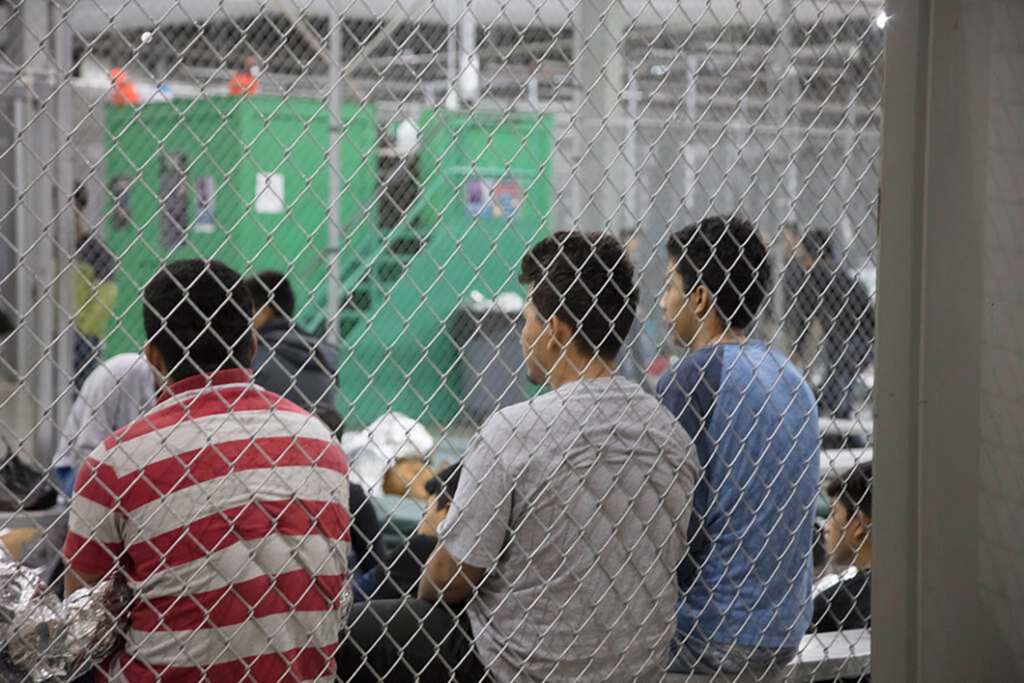I keep thinking about José René Flores, a Los Angeles resident incarcerated at a Southern California migrant detention facility in the 1980s. The El Centro Detention Facility, where immigration agents sent Flores, has a long and deep history of brutality. But Flores’ story is not just one of violence and violation. It is also a story of protest and solidarity—reflective of a larger lineage of resistance from inside detention, including the people the Trump administration is currently working to silence and disappear.
They’ve risked their “rightless” lives with the hope that the world might learn about the inhumane conditions behind detention walls, and that they might be free.
Flores migrated to the United States from El Salvador in 1980, after being attacked by members of the National Guard, a paramilitary organization known for committing atrocities during the Salvadoran Civil War. A teenager, he was targeted for his involvement in a factory trade union and for participating in the revolutionary organization Frente de Acción Popular Unificada (FAPU).
“There was terrible repression in El Salvador,” Flores told me when I interviewed him several years ago. “I was criminalized for having long hair and black glasses. Just looking different and being young meant you were a criminal, marijuanero, guerrillero, and a drug addict.”
When Flores arrived in Los Angeles, he was apprehended by Immigration and Naturalization Service (INS) officials, who transported him to El Centro because he chose to apply for political asylum.
The detention center, located in California’s Imperial Valley, was built to incarcerate unauthorized Mexican men and those convicted of deportable crimes in 1945. By the time Flores got there, it had evolved from a small camp into a large-scale facility with a deep history of labor exploitation, physical abuse, and surveillance.
INS officials forced Flores and his fellow detained migrants to work as low-paid and sometimes unpaid laborers, limited their access to low-nutrient food and medical care, and oversaw a climate of physical and psychological intimidation.
Flores and a few other Salvadoran migrants decided to fight back. “All of us felt the same,” Flores said. “Offended. Mistreated. We wanted to tell each other not to be sad. That we were all in this together.”
In 1981, they began a 15-day hunger strike. Their refusal to eat and the use of their bodies to protest called out the violence of the state, making the public aware of the punitive nature of detention. Due to the protest and the efforts of the immigrant aid group Concilio Manzo, the INS released Flores from the facility that same year.
Soon after, in 1985, a much larger hunger strike at El Centro made international news. Fifteen migrants from around the world organized an eight-day hunger strike. Between 175 and 300 incarcerated men participated, demanding that their grievances be heard.
While official INS accounts asserted that the detention center functioned simply as an administrative holding site where people waited for their deportation hearings, the stories the strikers shared with lawyers and the media framed the detention center as a site of punishment.
The protesters also publicized an important factor missing from the INS narrative: why many Central Americans had migrated to the U.S. in the first place. A number of the protesters were experienced organizers in their home countries who had been persecuted for fighting back against repressive Latin American regimes that were funded by U.S. tax dollars.
The 1985 strike resulted in further repression from INS officers. But it also helped shift the narrative around detention in the public eye, even as the U.S. continued to incarcerate immigrants and asylum seekers at sites such as the Krome North Service Processing Center in Florida, the Port Isabel Service Processing Center in Texas, and Guantanamo Bay in Cuba under both Democratic and Republican administrations.
Acts of resistance and protest from people behind detention walls have not stopped. In the decades that have followed, migrants have demanded that lawyers and immigrant rights organizations hear and document their stories, filed class action lawsuits, and staged acts of defiance, like refusing to eat or work to challenge the cruelty of the state.
Flores’ story is not just one of violence and violation. It is also a story of protest and solidarity—reflective of a larger lineage of resistance from inside detention.
The disappearance and isolation of migrants has escalated under Trump’s “Reign of Terror.” While the strategic placement of immigration detention facilities in isolated areas is an old practice, the Trump administration took it further in February of this year when it transferred hundreds of people to El Salvador’s Centro de Confinamiento del Terrorismo, commonly known as CECOT.
For almost four months, the U.S. government kept the identities of those transferred secret and did not allow them to contact their families or lawyers. In CECOT, they faced violence, torture, and in some cases sexual abuse by prison guards, with inadequate food and under inhumane conditions.
In March, some of those confined at CECOT organized a three-day hunger strike to demand contact with relatives and updates on their cases. According to Andres Morales, a Venezuelan migrant detained at CECOT who has since been released, when their efforts were unsuccessful, some of them held a blood strike, cutting themselves to write SOS on the prison walls.
The persistence of the incarcerated, as well as that of their loved ones, is one of the only reasons we know as much as we do about CECOT today. The Supreme Court blocked the practice of transferring people from the U.S. to CECOT in May.
But since then, the current administration has continued to build up the infrastructure for detention in the U.S., as demonstrated by the opening of new and old ICE facilities including “Alligator Alcatraz,” and at Louisiana’s Angola prison, Camp J, which Trump termed “the Louisiana Lockup.”
Growing cases of ICE overreach, including deporting migrants before their scheduled hearings and losing track of incarcerated people, are not accidental but part of an intentionally cruel and punitive system that operates as much as possible in the shadows.
As of September, the Miami Herald could not determine “the whereabouts of two-thirds of more than 1,800 men detained at Alligator Alcatraz during the month of July,” leaving their loved ones to imagine the worst.
Increasing and widespread repression inside ICE facilities has resulted in growing dissent. At the end of September, 19 incarcerated migrants commenced a hunger strike inside Camp J, calling for basic standards of care, such as prescription medication, toilet paper, and clean water.
These acts of resistance and refusal from the inside show that, despite carceral efforts to control, isolate, and strip migrants of their humanity, people will continue to find ways to fight back.
*Jessica Ordaz is an associate professor of ethnic studies at the University of Colorado Boulder. She is the author of* *The Shadow of El Centro: A History of Migrant Incarceration and Solidarity.*
https://www.zocalopublicsquare.org/resisting-migrant-detention-from-the-inside/

